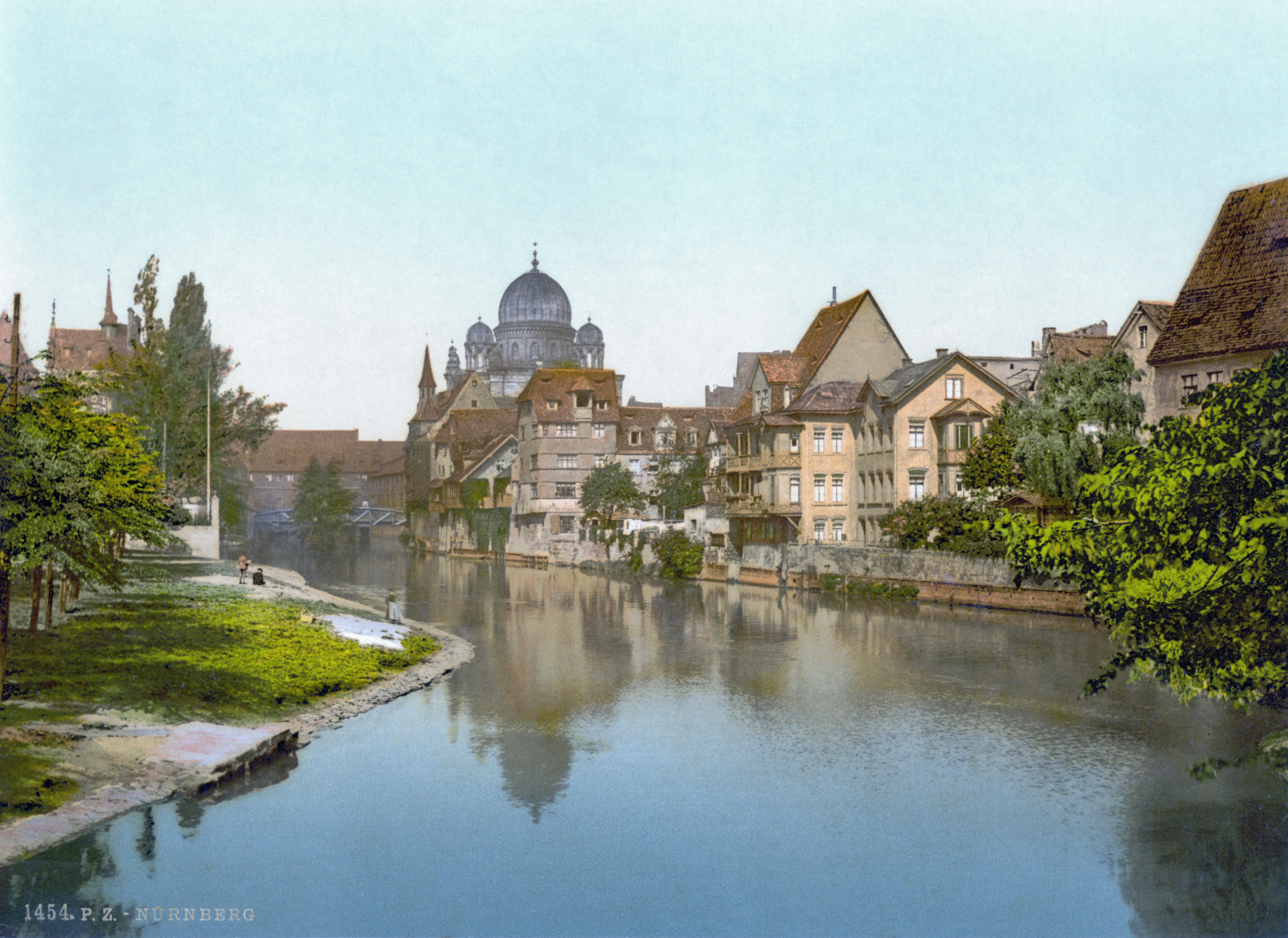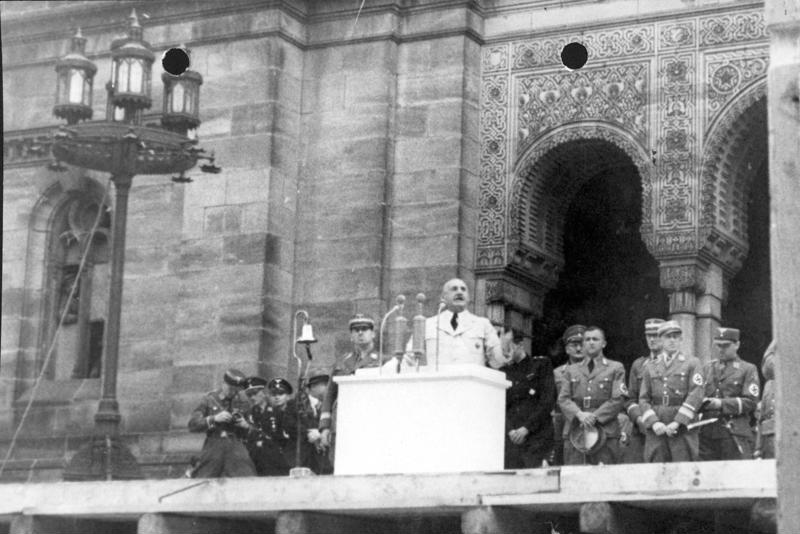Grand Synagogue of Nuremberg on:
[Wikipedia]
[Google]
[Amazon]
The Grand Synagogue of Nuremberg, completed in 1874 and destroyed in 1938, was the third synagogue in 
 The synagogue, located at Hans-Sachs-Platz, connected elements of Christian church architecture with oriental decoration, and symbolized the integration of Jews into the city's society after a 400-year ban on Judaism. Also, the synagogue was cherished by tourists, and was called the ''Perle in der Silhouette und Zierde der Stadt'' ("pearl in the skyline and adornment of the town").
It was designed by Adolf Wolff (1832-1885) for the city's approximately 300 Jewish families at a cost of 46,000 florins. The first stone was installed in 1870, and the grand opening was on 8 and 9 September 1874, with the leaders of the area's various Christian communities attending.
It had seating for 389 women and 546 men.
In 1875, an organ was installed.
In 1886,
The synagogue, located at Hans-Sachs-Platz, connected elements of Christian church architecture with oriental decoration, and symbolized the integration of Jews into the city's society after a 400-year ban on Judaism. Also, the synagogue was cherished by tourists, and was called the ''Perle in der Silhouette und Zierde der Stadt'' ("pearl in the skyline and adornment of the town").
It was designed by Adolf Wolff (1832-1885) for the city's approximately 300 Jewish families at a cost of 46,000 florins. The first stone was installed in 1870, and the grand opening was on 8 and 9 September 1874, with the leaders of the area's various Christian communities attending.
It had seating for 389 women and 546 men.
In 1875, an organ was installed.
In 1886,

File:Nuernberg Ansichtskarte 035.jpg, Postcard, 1900
File:Nurnberg Synagogue.jpg, Photo from the Library of Congress, circa 1900
File:Nuernberg Ansichtskarte 052.jpg, Circa 1900
File:Die Baudenkmäler der Stadt Nürnberg 038 Synagoge.jpg, View from Pegnitz bridge (1891)
File:Model of Main Synagogue of Nuremberg, modern Pinakothek museum in Munich, Exhibition Ludwig II, 2018.jpg, Model of Main Synagogue of Nuremberg, modern Pinakothek museum in Munich, Exhibition Ludwig II, 2018
File:Vy vid Pegnitz med synagogan - TEK - TEKA0119037.tif, 1901
Nuremberg
Nuremberg ( ; german: link=no, Nürnberg ; in the local East Franconian dialect: ''Nämberch'' ) is the second-largest city of the German state of Bavaria after its capital Munich, and its 518,370 (2019) inhabitants make it the 14th-largest ...
, and was built after the plans of architect Adolf Wolff.

Previous synagogues in Nuremberg
The first medieval age synagogue stood on the site of today's Frauenkirche at the Hauptmarkt, and it was destroyed during the anti-Jewishpogrom
A pogrom () is a violent riot incited with the aim of massacring or expelling an ethnic or religious group, particularly Jews. The term entered the English language from Russian to describe 19th- and 20th-century attacks on Jews in the Russia ...
s of 1349. A second one was located at the Wunderburggasse, and was destroyed in 1499 during another pogrom.
Architecture and history
 The synagogue, located at Hans-Sachs-Platz, connected elements of Christian church architecture with oriental decoration, and symbolized the integration of Jews into the city's society after a 400-year ban on Judaism. Also, the synagogue was cherished by tourists, and was called the ''Perle in der Silhouette und Zierde der Stadt'' ("pearl in the skyline and adornment of the town").
It was designed by Adolf Wolff (1832-1885) for the city's approximately 300 Jewish families at a cost of 46,000 florins. The first stone was installed in 1870, and the grand opening was on 8 and 9 September 1874, with the leaders of the area's various Christian communities attending.
It had seating for 389 women and 546 men.
In 1875, an organ was installed.
In 1886,
The synagogue, located at Hans-Sachs-Platz, connected elements of Christian church architecture with oriental decoration, and symbolized the integration of Jews into the city's society after a 400-year ban on Judaism. Also, the synagogue was cherished by tourists, and was called the ''Perle in der Silhouette und Zierde der Stadt'' ("pearl in the skyline and adornment of the town").
It was designed by Adolf Wolff (1832-1885) for the city's approximately 300 Jewish families at a cost of 46,000 florins. The first stone was installed in 1870, and the grand opening was on 8 and 9 September 1874, with the leaders of the area's various Christian communities attending.
It had seating for 389 women and 546 men.
In 1875, an organ was installed.
In 1886, Luitpold, Prince Regent of Bavaria
''Leopold Charles Joseph William Louis''
, image_size =
, image = Luitpold Wittelsbach cropped.jpg
, succession = Prince Regent of Bavaria
, reign = 10 June 1886 – 12 December 1912
, reign-type = Tenure
, regent = Ludw ...
visited.
In September 1897, Wilhelm II, German Emperor
Wilhelm II (Friedrich Wilhelm Viktor Albert; 27 January 18594 June 1941) was the last German Emperor (german: Kaiser) and King of Prussia, reigning from 15 June 1888 until his abdication on 9 November 1918. Despite strengthening the German Empir ...
visited with his wife and two of his children. He met with the senior Rabbi, Dr. Ziemlich, and asked him about the city's Jewish community and compared the synagogue with another he had visited in Prague.
In August 1938, the synagogue was seized and destroyed on the orders of mayor Willy Liebel and Julius Streicher
Julius Streicher (12 February 1885 – 16 October 1946) was a member of the Nazi Party, the ''Gauleiter'' (regional leader) of Franconia and a member of the '' Reichstag'', the national legislature. He was the founder and publisher of the virul ...
, the Gauleiter
A ''Gauleiter'' () was a regional leader of the Nazi Party (NSDAP) who served as the head of a ''Administrative divisions of Nazi Germany, Gau'' or ''Reichsgau''. ''Gauleiter'' was the third-highest Ranks and insignia of the Nazi Party, rank in ...
of Franconia
Franconia (german: Franken, ; Franconian dialect: ''Franggn'' ; bar, Frankn) is a region of Germany, characterised by its culture and Franconian dialect (German: ''Fränkisch'').
The three administrative regions of Lower, Middle and Upper Fr ...
, who stated that it was architecturally offensive. The process of destruction was interrupted by the Reichsparteitag
The Nuremberg Rallies (officially ', meaning ''Reich Party Congress'') refer to a series of celebratory events coordinated by the Nazi Party in Germany. The first rally held took place in 1923. This rally was not particularly large or impactful; ...
and was only completed on 27 September 1938.
The community produced some of Germany's leading Reform Judaism
Reform Judaism, also known as Liberal Judaism or Progressive Judaism, is a major Jewish denomination that emphasizes the evolving nature of Judaism, the superiority of its ethical aspects to its ceremonial ones, and belief in a continuous searc ...
scholars. In 1902, a smaller Orthodox Synagogue was established in Nuremberg. It was destroyed in 1938 during the Kristallnacht
() or the Night of Broken Glass, also called the November pogrom(s) (german: Novemberpogrome, ), was a pogrom against Jews carried out by the Nazi Party's (SA) paramilitary and (SS) paramilitary forces along with some participation from ...
.
Rabbis
1874 - 1880 Dr. Moritz Lewin - Later became a leader of Berlin's Reform Judaism movement. 1881 - 1907 Dr. Pincus Bernhard Ziemlich 1907 - 1934 Dr. Max Freudenthal 1912 - 1939 Dr. Isaak (Ernst) Heilbronn - Fled to the USA in 1939 and became a rabbi at Congregation Beth Hillel in New York
Gallery
Post-war era
After the war ended, the city of Nuremberg did not decide to reconstruct the synagogue, in spite of the area being not overbuilt and available for construction work. Also, the winning entry of Nuremberg's 1947 architectural competition - intended to gather the best plans on how to rebuild the city - did not envision a synagogue on its original premises. Heinz Schmeißner, who won the prize, was also the city's official for surface construction from 1937 to 1945, and thus he also formally oversaw the destruction of the synagogue.References
{{coord, 49, 27, 12 , N, 11, 04, 47, E, display=title Synagogues in Germany Synagogues completed in 1874 Demolished buildings and structures in Germany Kristallnacht Synagogues destroyed during Kristallnacht (Germany) Former synagogues in Germany Reform synagogues in Germany